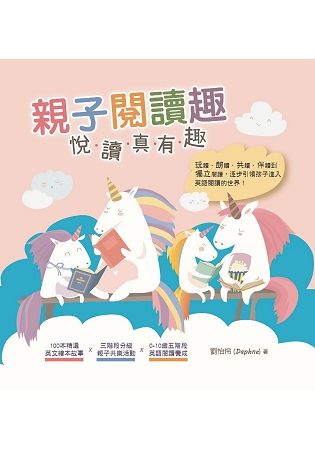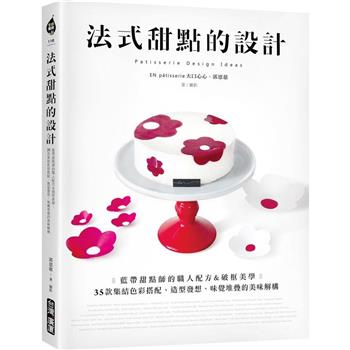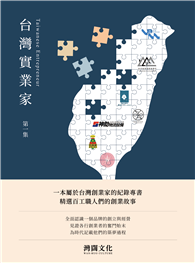玩讀、朗讀、共讀、伴讀到獨立閱讀,逐步引領孩子進入英語閱讀的世界!
研究顯示要學好英文,長遠之計還是在於英語閱讀的養成。然而,許多家長卻對於在家與孩子進行英語閱讀,不知從何挑起及從何做起。
此書希望能讓父母陪伴孩子:
●在家進行英語閱讀
●提升孩子英語能力
●增進親子閱讀樂趣
●成功奠定閱讀習慣
本書除了包含常見的經典繪本,有逾半數的推薦書目為近期出版的優質書籍。並根據孩子閱讀發展進程分為
五階段建議,各階段提供以下說明:該年齡具備的閱讀相關能力及發展建議、20 本書籍介紹及2 個常見問題。
5 階段說明
• Learn to Read: 0-2 歲、3-4 歲、5-6 歲。
從厚頁書、互動書到有趣的繪本故事,讓孩子從閱讀中建立文字概念到文字應用。豐富多元的閱讀內容,讓孩子認識文字、愛上閱讀。
• Read to Learn: 7-8 歲、9-10 歲。
閱讀選擇的多樣性,有繪本外,更增添章節故事、知識性讀本,讓孩子從閱讀中學習到知識、培養思考批判能力,奠定終身學習的良好閱讀基礎。
媽咪的悄悄話:提供引導此書給孩子時的相關互動經驗或引導過程中的小故事。
故事簡介:簡述書中的大意。
學習目標:故事涵蓋的學習內容
看故事學英語:重要或艱難的字彙或重要句型的整理,讓閱讀者能事先預習,或在進行閱讀活動時,運用這些重點來與孩子互動。
親子活動123:針對每本故事提供與孩子互動的三個小建議。
活動1:最簡易的建議,可在數分鐘內完成相關互動。
活動2:進階版建議,需要時間及難度提高。
活動3:高階版建議,需要孩子及家長較多的互動及思考時間。
小叮嚀:針對各書中可能觸及到的相關議題做貼心的小說明。
好書推薦:建議兩本相關書籍,提供延伸閱讀。
本書特色
特色1
五階段分齡,推薦適齡英語好書
從0-10歲分五階段推薦適合的英語故事及繪本,根據各階段的成長發展,精心挑選各20本書籍,讓孩子循序漸進的習慣,並喜歡英語故事。
特色2
清楚解釋書籍大綱及學習目標
簡單扼要地說明故事情節,提供父母針對生活上的需求做選擇;並將書中的學習重點做整理,讓孩子能透過故事達到潛移默化的學習效果。
特色3
重點整理故事中的字彙及句型
挑選重點或較難字彙及常用句型,提供父母在閱讀故事前先預習,減少閱讀中可能會遇到的瓶頸。
特色4
善用親子活動1、2、3,增進親子共讀樂趣
針對故事內容量身設計三個不同程度的活動,清楚的活動步驟,輕鬆地與孩子在閱讀後進行親子互動。
| FindBook |
有 5 項符合
親子閱讀趣‧悅讀真有趣的圖書 |
| 圖書選購 |
| 型式 | 價格 | 供應商 | 所屬目錄 | 二手書 |
$ 131 |
二手中文書 |
$ 383 |
培養閱讀力 |
$ 396 |
中文書 |
$ 396 |
少兒語言學習 |
$ 405 |
語文學習 |
|---|
| 圖書館借閱 |
| 國家圖書館 | 全國圖書書目資訊網 | 國立公共資訊圖書館 | 電子書服務平台 | MetaCat 跨館整合查詢 |
| 臺北市立圖書館 | 新北市立圖書館 | 基隆市公共圖書館 | 桃園市立圖書館 | 新竹縣公共圖書館 |
| 苗栗縣立圖書館 | 臺中市立圖書館 | 彰化縣公共圖書館 | 南投縣文化局 | 雲林縣公共圖書館 |
| 嘉義縣圖書館 | 臺南市立圖書館 | 高雄市立圖書館 | 屏東縣公共圖書館 | 宜蘭縣公共圖書館 |
| 花蓮縣文化局 | 臺東縣文化處 |
|
|
圖書介紹 - 資料來源:博客來 評分:
圖書名稱:親子閱讀趣‧悅讀真有趣
內容簡介
作者介紹
作者簡介
劉怡伶 (Daphne)
澳洲昆士蘭科技大學 英語教學系碩士
曾任
培生朗文教學顧問
補習班教務主任
出版編輯主任
從事英語教學多年的Daphne,婚後旅美居住數年,從忙碌的職業婦女,轉變成全職的家庭主婦;從不會下廚到與孩子一同手作各類點心;從教導學生到教育自已的孩子,每與孩子一同玩讀、共讀繪本故事,並在Facebook擔任『親子閱讀趣』的版主,鼓勵身的朋友一同從孩子的角度來重新體會各種事物的新鮮感!
劉怡伶 (Daphne)
澳洲昆士蘭科技大學 英語教學系碩士
曾任
培生朗文教學顧問
補習班教務主任
出版編輯主任
從事英語教學多年的Daphne,婚後旅美居住數年,從忙碌的職業婦女,轉變成全職的家庭主婦;從不會下廚到與孩子一同手作各類點心;從教導學生到教育自已的孩子,每與孩子一同玩讀、共讀繪本故事,並在Facebook擔任『親子閱讀趣』的版主,鼓勵身的朋友一同從孩子的角度來重新體會各種事物的新鮮感!
目錄
推薦序 – 李佳曄
推薦序 – 張裕昌
推薦序 – Michael Cahill
作者序
本書特色
Part 1 0-2 歲 玩讀 起步走
Part 2 3-4 歲 朗讀 輕鬆聽
Part 3 5-6 歲 共讀 親子樂
Part 4 7-8 歲 伴讀 趣味多
Part 5 9-10 歲 獨立閱讀 一級棒
閱讀與未來教育
閱讀紀錄表
推薦序 – 張裕昌
推薦序 – Michael Cahill
作者序
本書特色
Part 1 0-2 歲 玩讀 起步走
Part 2 3-4 歲 朗讀 輕鬆聽
Part 3 5-6 歲 共讀 親子樂
Part 4 7-8 歲 伴讀 趣味多
Part 5 9-10 歲 獨立閱讀 一級棒
閱讀與未來教育
閱讀紀錄表
序
推薦序
一本有愛的英語學習書
張裕昌 副總經理/世紀奧美公關顧問公司
不斷在國外旅行,以及喜好看電影及影集的我,深切了解到一件事,就是學習語言如果不能奠基在一個從「興趣與實用」出發的先決條件上,那麼這樣的學習是很淺薄且容易忘記的。道理很簡單,因為學了不知道該怎麼用,或用在哪裡。因此小時候,我不管如何被體罰或責罵,我始終不知道學習這26 個字母的用意到底是為什麼。
之前在我服務的公司(師德文教),我常常看到許多孩子們,為了拿到一紙檢定證書,而不斷的反覆背誦,當時我心裡的疑問是,到底這些因考試而強記下來的片段資料,會在記憶當中留存多久呢?有些學生甚至會因為考試成績不佳而接受程度不一的責難,這樣的學習結果會是好的嗎?
所以當我看到妹妹這本書的初稿時,我深深覺得,一本有愛的EFL/ESL 學習書,對並非英語母語的台灣小朋友來說有多重要。原因無他,這本書不是只讓孩子們記憶一些他可有可無的東西,而是在親子互動的過程當中,讓孩子產生對語言學習的興趣。更重要的是,這本書如果沒有父母親充滿愛心與耐心與孩子一起閱讀,孩子不會從這些愛心與耐心當中了解學習第二語言的樂趣。
因此,我誠摯的推薦這本書給每位父母親,如果您們真的希望孩子們學好第二外語,那麼,在他們學習的初始,您們充滿愛心與耐心的參與是絕對必須的,而當他們從一開始就培養好學習語言的興趣與樂趣之後,未來,就放手讓他們在語言的國度中悠遊自得吧!
Exploring this Amazing World
National Geographic Learning
Michael Joseph Cahill
Senior Regional Director
The world is an amazing place, filled with exciting and inspiring people, places, and stories: stories that have the power to engage and motivate learners, and stories that have the power to transform lives. Learning is an emotional and a social process. Your role in your child’s attitudes and beliefs towards learning cannot be overstated.
Preparing children for this amazing and ever-changing world can be a parent’s and an educator’s biggest challenge. An expert who shares that challenge and can offer useful practical advice is invaluable. For parents and educators especially interested in preparing a child to thrive in an ever more connected and competitive world, I can think of no greater expert than Daphne Liu, your guide to 「親子閱讀趣 – 悅讀真有趣」.
With over twenty years of experience in language learning, teaching, research and material development, Ms. Liu is uniquely prepared to assist parents interested in developing a child’s love of language, stories, culture, and learning.
With children of her own, Ms. Liu understands that motivating a child to learn pays a dividend that goes beyond a score, a test, or even subject knowledge. Through the activities and guidance suggested in「親子閱讀趣 – 悅讀真有趣」, Ms. Liu supports parents with the inspiration and the tools to tap into a child’s sense of adventure and exploration.
Why is this important?
Language learning has changed and evolved over the past twenty to thirty years. Driven by changes in the workplace, and as reflected in the most recent national curricula, today’s language learning is focused on communicative competence. First introduced in 1966 the concept of language competence was introduced in reaction to perceived inadequacies in the distinction between language knowledge and language performance. The four components of communicative competence can be broken down as follows: linguistic competence, the knowledge of grammar, vocabulary, syntax; sociolinguistic competence, knowing when and with whom to use language appropriately; discourse competence, the ability to comprehend and create a variety of text types, both spoken and written; and strategic competence, the ability to overcome gaps in
communication.
While none of these competences are new, the need to actively address each of them more holistically has taken on increasing importance with the greater focus on the so-called soft skills, otherwise known as 21st century skills, higher order thinking skills, or sometimes simply as core student competencies. In the International Baccalaureate© or IB curriculum, this is reflected in the Learner Profile. This profile includes characteristics of learners as knowledgeable, communicative, principled, and reflective. In the New Pedagogies for Deep Learning these are reflected in the Deep Learning Competencies: collaboration, creativity, critical thinking, citizenship, character, and communication. In the United States, the world readiness standards for learning languages describes these as the five “C” goal areas, communication, cultures, connections, comparisons, and communities.
Our children will need to compete on a world stage. And, as recent focus around the world on STEM and STEAM education points to, the ability to speak a foreign language has become a foundational skill like mathematics or science or technology. A must have. In working with some of the world’s most reputable developers of language learning materials, it has been my experience to observe, explore, and respond to these challenges. Most recently, at National Geographic Learning, it has been my strong belief the learning should be exciting, inspiring, and transformative. We believe that an engaged and motivated learner will be a successful one, and we design our learning materials with a highly interactive storytelling approach which is a great way to invoke these
connections.
If you are interested in engaging and motivating children, then I strongly recommend Ms. Liu and「親子閱讀趣 – 悅讀真有趣」as your guide. May you and your child’s learning journey be equally exciting, inspiring, and transformative!
作者序
親子閱讀趣 – 用愛種下閱讀的種子
出這本書有兩個很重要的想法,一個是推廣親子閱讀的重要性,另一個則是鼓勵英文親子閱讀的落實性。曾從事英語教學及編輯工作過的我,看著許多學生在補英文的過程中浮浮沉沉;而家長們很努力地從小就讓孩子接觸英文學習,但在國小或國中後看不到這長期學習下來應有的成效。原因為何呢?關鍵在於「英語閱讀」。
若要英文學得好,英文閱讀不能少。但因環境的關係,大家都會寄望在補習班的學習,殊不知與孩子一起共讀英文故事,累積的成果才是驚人的。而閱讀習慣的養成更非一朝一夕可得,這是需要堅持一段漫長歲月,才能看到美麗果實的長期投資。親子閱讀的過程,不僅是為了要提升孩子的閱讀能力,更重要的是在這短短的時間裡,它給了彼此美好的互動,在閱讀中,孩子能感受到父母親滿滿的付出及愛。
曾經, 我父親在忙碌的外調出差工作之餘,一到家的第一件事就是拿出新買的書,在我的床邊唸故事給我聽,而這成為我日後回憶父親最美最美的畫面。現在,我也將這份愛的閱讀種子,種在我兩個孩子的心中。希望這個種子能帶給他們在面對未來各種挑戰時,能有解決事情或抒發情緒的能力。寫書對我來說曾經是遙不可及的想法,因深知出書過程的不易,但在佳曄姊的鼓勵下,寫了人生的第一本書,除了希望能推廣親子閱讀的重要性外,更希望能讓想奠定孩子英語閱讀習慣的爸媽們一些方向。透過這本書,我想要把父親曾努力在我心中種下的閱讀種子,繼續散播出去。謝謝父親用床邊閱
讀時間陪伴我成長,感謝母親用滿滿的愛照顧我和弟弟。
在孩子們心中用愛種下閱讀的種子,
總有一天,會讓孩子開出美麗又豐富的人生花朵!
一本有愛的英語學習書
張裕昌 副總經理/世紀奧美公關顧問公司
不斷在國外旅行,以及喜好看電影及影集的我,深切了解到一件事,就是學習語言如果不能奠基在一個從「興趣與實用」出發的先決條件上,那麼這樣的學習是很淺薄且容易忘記的。道理很簡單,因為學了不知道該怎麼用,或用在哪裡。因此小時候,我不管如何被體罰或責罵,我始終不知道學習這26 個字母的用意到底是為什麼。
之前在我服務的公司(師德文教),我常常看到許多孩子們,為了拿到一紙檢定證書,而不斷的反覆背誦,當時我心裡的疑問是,到底這些因考試而強記下來的片段資料,會在記憶當中留存多久呢?有些學生甚至會因為考試成績不佳而接受程度不一的責難,這樣的學習結果會是好的嗎?
所以當我看到妹妹這本書的初稿時,我深深覺得,一本有愛的EFL/ESL 學習書,對並非英語母語的台灣小朋友來說有多重要。原因無他,這本書不是只讓孩子們記憶一些他可有可無的東西,而是在親子互動的過程當中,讓孩子產生對語言學習的興趣。更重要的是,這本書如果沒有父母親充滿愛心與耐心與孩子一起閱讀,孩子不會從這些愛心與耐心當中了解學習第二語言的樂趣。
因此,我誠摯的推薦這本書給每位父母親,如果您們真的希望孩子們學好第二外語,那麼,在他們學習的初始,您們充滿愛心與耐心的參與是絕對必須的,而當他們從一開始就培養好學習語言的興趣與樂趣之後,未來,就放手讓他們在語言的國度中悠遊自得吧!
Exploring this Amazing World
National Geographic Learning
Michael Joseph Cahill
Senior Regional Director
The world is an amazing place, filled with exciting and inspiring people, places, and stories: stories that have the power to engage and motivate learners, and stories that have the power to transform lives. Learning is an emotional and a social process. Your role in your child’s attitudes and beliefs towards learning cannot be overstated.
Preparing children for this amazing and ever-changing world can be a parent’s and an educator’s biggest challenge. An expert who shares that challenge and can offer useful practical advice is invaluable. For parents and educators especially interested in preparing a child to thrive in an ever more connected and competitive world, I can think of no greater expert than Daphne Liu, your guide to 「親子閱讀趣 – 悅讀真有趣」.
With over twenty years of experience in language learning, teaching, research and material development, Ms. Liu is uniquely prepared to assist parents interested in developing a child’s love of language, stories, culture, and learning.
With children of her own, Ms. Liu understands that motivating a child to learn pays a dividend that goes beyond a score, a test, or even subject knowledge. Through the activities and guidance suggested in「親子閱讀趣 – 悅讀真有趣」, Ms. Liu supports parents with the inspiration and the tools to tap into a child’s sense of adventure and exploration.
Why is this important?
Language learning has changed and evolved over the past twenty to thirty years. Driven by changes in the workplace, and as reflected in the most recent national curricula, today’s language learning is focused on communicative competence. First introduced in 1966 the concept of language competence was introduced in reaction to perceived inadequacies in the distinction between language knowledge and language performance. The four components of communicative competence can be broken down as follows: linguistic competence, the knowledge of grammar, vocabulary, syntax; sociolinguistic competence, knowing when and with whom to use language appropriately; discourse competence, the ability to comprehend and create a variety of text types, both spoken and written; and strategic competence, the ability to overcome gaps in
communication.
While none of these competences are new, the need to actively address each of them more holistically has taken on increasing importance with the greater focus on the so-called soft skills, otherwise known as 21st century skills, higher order thinking skills, or sometimes simply as core student competencies. In the International Baccalaureate© or IB curriculum, this is reflected in the Learner Profile. This profile includes characteristics of learners as knowledgeable, communicative, principled, and reflective. In the New Pedagogies for Deep Learning these are reflected in the Deep Learning Competencies: collaboration, creativity, critical thinking, citizenship, character, and communication. In the United States, the world readiness standards for learning languages describes these as the five “C” goal areas, communication, cultures, connections, comparisons, and communities.
Our children will need to compete on a world stage. And, as recent focus around the world on STEM and STEAM education points to, the ability to speak a foreign language has become a foundational skill like mathematics or science or technology. A must have. In working with some of the world’s most reputable developers of language learning materials, it has been my experience to observe, explore, and respond to these challenges. Most recently, at National Geographic Learning, it has been my strong belief the learning should be exciting, inspiring, and transformative. We believe that an engaged and motivated learner will be a successful one, and we design our learning materials with a highly interactive storytelling approach which is a great way to invoke these
connections.
If you are interested in engaging and motivating children, then I strongly recommend Ms. Liu and「親子閱讀趣 – 悅讀真有趣」as your guide. May you and your child’s learning journey be equally exciting, inspiring, and transformative!
作者序
親子閱讀趣 – 用愛種下閱讀的種子
出這本書有兩個很重要的想法,一個是推廣親子閱讀的重要性,另一個則是鼓勵英文親子閱讀的落實性。曾從事英語教學及編輯工作過的我,看著許多學生在補英文的過程中浮浮沉沉;而家長們很努力地從小就讓孩子接觸英文學習,但在國小或國中後看不到這長期學習下來應有的成效。原因為何呢?關鍵在於「英語閱讀」。
若要英文學得好,英文閱讀不能少。但因環境的關係,大家都會寄望在補習班的學習,殊不知與孩子一起共讀英文故事,累積的成果才是驚人的。而閱讀習慣的養成更非一朝一夕可得,這是需要堅持一段漫長歲月,才能看到美麗果實的長期投資。親子閱讀的過程,不僅是為了要提升孩子的閱讀能力,更重要的是在這短短的時間裡,它給了彼此美好的互動,在閱讀中,孩子能感受到父母親滿滿的付出及愛。
曾經, 我父親在忙碌的外調出差工作之餘,一到家的第一件事就是拿出新買的書,在我的床邊唸故事給我聽,而這成為我日後回憶父親最美最美的畫面。現在,我也將這份愛的閱讀種子,種在我兩個孩子的心中。希望這個種子能帶給他們在面對未來各種挑戰時,能有解決事情或抒發情緒的能力。寫書對我來說曾經是遙不可及的想法,因深知出書過程的不易,但在佳曄姊的鼓勵下,寫了人生的第一本書,除了希望能推廣親子閱讀的重要性外,更希望能讓想奠定孩子英語閱讀習慣的爸媽們一些方向。透過這本書,我想要把父親曾努力在我心中種下的閱讀種子,繼續散播出去。謝謝父親用床邊閱
讀時間陪伴我成長,感謝母親用滿滿的愛照顧我和弟弟。
在孩子們心中用愛種下閱讀的種子,
總有一天,會讓孩子開出美麗又豐富的人生花朵!
|










